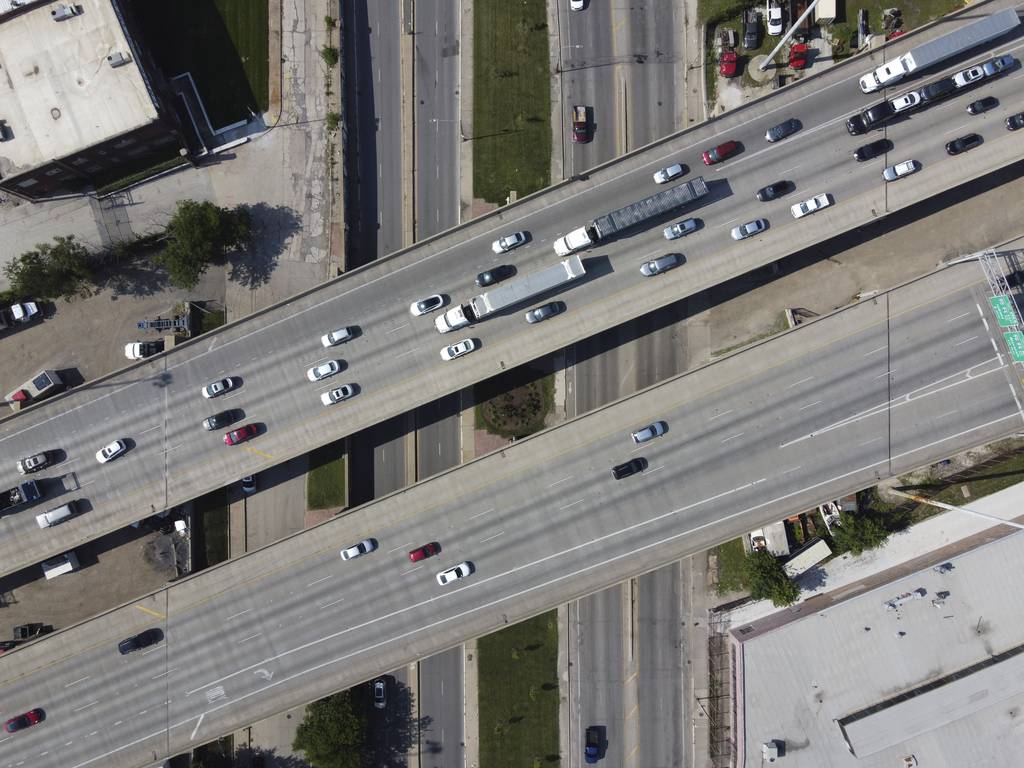Politically powerful labor unions flexed their muscle in Springfield this spring to push through a measure that could clear the way for privately managed toll lanes on congested Interstate 55, giving new life to a concept that’s been floated for more than a decade.
But the effort, led primarily by the International Union of Operating Engineers Local 150, also further inflamed tensions between organized labor and environmentalists, two core constituencies for Democrats who control state government.
Whether adding toll lanes along I-55, from Interstate 355 to the Dan Ryan Expressway, comes to fruition or joins proposals like the Illiana toll road and Peotone airport on the state’s list of long-discussed but as-yet-unrealized transportation projects remains to be seen. Democratic Gov. J.B. Pritzker and his Illinois Department of Transportation have both expressed ambivalence toward the concept.
Pritzker acknowledged in an interview with the Tribune last month that “there’s very much a divide” between organized labor and environmental groups on the issue. Similar discord arose during negotiations over the landmark energy and climate measure he signed two years ago and the more recent debate over a proposal now on Pritzker’s desk that would lift a decades-old moratorium on the construction of new nuclear power plants in Illinois.
“You do need to reach some consensus about this,” Pritzker said, adding that he was “still studying the matter” and hadn’t “made a decision about how to proceed.”
At the heart of the disagreement is whether adding more lanes within the existing footprint of I-55 would reduce congestion and air pollution or result in more traffic and pollution, a particularly sensitive issue in communities like the Little Village neighborhood on the Southwest Side that already receive more than their share of dirty air.
There’s also the question of whether the state should bring in a private partner to run the toll road portion of the expressway, parts of which average up to 160,000 vehicles per day, rather than leaving that job to the Illinois Tollway.
“Those things have not really been aired,” Pritzker said.
The I-55 proposal was addressed in two pieces of legislation that were approved with bipartisan support in the final days of the General Assembly’s spring session.
Lawmakers added language to a broad measure addressing rules for how the state purchases goods and services that would allow IDOT and other public agencies to accept unsolicited proposals from private entities to partner on transportation projects like the I-55 toll lanes. That requires the governor’s signature to become law.
Separately, the House and Senate approved a joint resolution, which doesn’t require a signature from Pritzker, that gives IDOT the authority to pursue adding an express toll lane in each direction from I-355 to the Tri-State Tollway and two lanes in each direction from the Tri-State to the Dan Ryan.
State Sen. Bill Cunningham, a Chicago Democrat who sponsored the resolution in the Senate, called it “a significant milestone in addressing the need for improved transportation infrastructure in our state.”
IDOT, however, has not fully embraced the concept, which was not included in the agency’s six-year plan for statewide transportation projects released earlier this month. For its part, the Illinois State Toll Highway Authority, which oversees the state’s 294 miles of existing toll roads, has taken no official position on the proposal, a spokeswoman said.
The idea of adding toll lanes to I-55 has been around at least a decade, since the Chicago Metropolitan Agency for Planning issued a recommendation to use congestion pricing — where tolls rise along with traffic demand in an effort to cut down on unnecessary trips — to reduce gridlock on I-55 and other clogged Chicago-area expressways.
The project appeared poised to pick up speed under Gov. Bruce Rauner in 2016 as part of the one-term Republican’s largely unsuccessful efforts to privatize functions of state government.
Most of those efforts were met with reactions ranging from skepticism to scorn by Democrats who controlled the legislature. But Rauner’s proposal to bring in a private company to build and manage toll lanes on I-55 was embraced by some key members of the majority party, even as much of Springfield’s business was mired in grueling partisan gridlock over the governor’s attempts to weaken labor unions.
When Rauner held a news conference to announce the idea, he was joined by lawmakers from both parties, including state Sen. Martin Sandoval, a Chicago Democrat who chaired the powerful Senate Transportation Committee. Sandoval, who died in 2020 after pleading guilty to an unrelated federal bribery charge involving a red-light camera company, praised the concept as “a win for taxpayers and drivers.”
The pitch was for the state to find a private partner to take over the congested stretch of expressway, with the responsibility for building the toll lanes within the existing median and maintaining the free lanes, while collecting the revenue from the tolls.
At the time, officials hoped the project could be completed in 2019. And while preliminary engineering and environmental studies were completed by the end of 2018, including environmental review by the Federal Highway Administration, the project has since languished. Until this year, lawmakers never gave IDOT the necessary authority to move forward.
A major factor was the Rauner administration’s effort to tie conversations about funding major infrastructure improvements to his proposals to weaken protections for labor unions under state law, said Marc Poulos, executive director of the Indiana, Illinois, Iowa Foundation for Fair Contracting and a lobbyist for Local 150.
“It became apparent that any conversation with that administration about capital expenditures was going to be met with, ‘Oh, yeah, we’re only interested in that if we can get rid of all these labor standards,’” said Poulos, a main proponent of the push to revive the project.
“It was like, ‘Alright, well, we’ll wait you out; we’ll wait for the next guy,’” Poulos said.
Even under union-friendly Pritzker, though, the project has remained on the shelf at IDOT.
The agency is “not pursuing these plans at this time and will be reviewing and evaluating next steps,” spokeswoman Maria Castaneda said.
Local 150 and other supporters argue that the time is ripe for the state to move forward with the long-dormant idea due to population growth and business development in southwest suburban Will County and along the I-55 corridor. Those factors have already increased traffic on the expressway. There’s also an appetite among private investors to put capital behind public-private infrastructure projects, Poulos said.
The project’s estimated cost is more than $2 billion. In addition to jobs, Local 150 and other unions are interested in investing money from their pension funds in such projects close to home, Poulos said.
“Why do we keep taking our money and investing in a project in California and in Virginia and in Florida and in Texas?” he said. “Why aren’t we investing your own money here … and then having your own workforce work on it?”
Poulos pointed to the recently completed Houbolt Road Bridge, a privately owned and operated 1.5-mile roadway and toll bridge that helps link Interstate 80 to the CenterPoint Intermodal Center near Joliet, as a model, albeit on a smaller scale. Local 150′s pension fund and the California state retirement system were among investors in the project.
Proponents also argue that by adding capacity to the highway and managing the demand through optional tolling with dynamic pricing, the project would reduce overall tailpipe emissions that harm human health and contribute to climate change.
CMAP has estimated the overhaul, which the regional planning agency has identified as a “regionally significant project,” would reduce greenhouse gas emissions along the corridor by 34.1 metric tons per day by 2050.
That’s where some environmentalists and planning experts disagree.
They point to a growing body of research that suggests, in the long term, adding more highway lanes increases congestion rather than reducing it.
“It’s a temporary fix,” said Lou Turner, an assistant professor in the University of Illinois’ Department of Urban and Regional Planning. “And then (traffic) increases. It kind of fills back in.”
With more space, more people feel like they can take to the road in their cars, said Sybil Derrible, an associate professor of civil, materials and environmental engineering at the University of Illinois at Chicago.
“It seems to be the commonsense solution, but for about 50 years we’ve tried it and it’s never solved traffic congestion,” he said. “Never.”
The way to ease congestion is to get people from one place to another in a way that takes up less space, Derrible said. That could mean carpooling — taking cars off the expressway while transporting the same number of people — or mass transit.
Fewer cars on the road would free up space for the delivery and industrial trucks that use I-55, he said. And investing in transit upgrades to remove drivers from the road would create jobs, just like a road project — while also helping to reduce congestion, he said.
The project also raises the issue of potentially bringing more cars through areas such as Little Village, a heavily Latino enclave that already suffers from poor air quality and high rates of respiratory illness.
“Everyone in the Chicago region would be worse off,” Derrible said. “It’s not only the people in the neighborhoods, who are absolutely unfairly treated right now. But it’s not just them. Everyone in the region would be worse off in the long run because we just have more congestion to deal with.”
Dixon Galvez-Searle, with the community organization The Southwest Collective, said if the state was going to make a large-scale investment in transportation on the Southwest Side of the city, he’d rather see it go toward improving other types of transit.
Walking, biking and taking public transit are already difficult in Southwest Side neighborhoods, where transit can be unreliable and sidewalks difficult to use, pushing more people to drive, he said.
“We’re never going to be able to build highways or streets that are wide enough to accommodate the number of cars that we’d need if cars are the only option,” he said.
The question is how to move people while minimizing negative effects, said Audrey Wennink, transportation director for the Metropolitan Planning Council. Both the CTA Orange Line and Metra’s Heritage Corridor run in the area around I-55, and both could stand to be improved through additional investment.
“There are opportunities for transit investment along this corridor,” Wennink said. “We already have rail lines. I think we need to be more innovative and multimodal as we look at transportation needs, and recognize that research done on this particular project has been sitting around for a number of years now, and I think we may be looking at solutions from an older perspective.”
Environmental groups and others used such arguments to try to convince lawmakers to block the plan but were ultimately unsuccessful, as they also were this spring in trying to defeat a union-backed measure that would lift the state’s ban on building new nuclear power plants.
The I-55 proposal was the first time in recent memory that the legislature took up a measure potentially authorizing a major highway expansion, said Jack Darin, director of the Illinois chapter of the Sierra Club.
“The concerns that we now have about environmental justice and about the climate emissions from highway expansions are new to the Illinois General Assembly, and therefore when these issues came up very late in the session, legislators haven’t had the experience in dealing with them,” Darin said.
“The limited number of days and even hours that the legislature had to consider these proposals didn’t really allow for considering all those impacts,” he said.
Environmental groups and other opponents also pushed for the legislation to require a study that would look at how much demand could be created through the addition of more lanes, but that was rejected.
That was because they were asking to “start looking at traffic modeling (in) a totally different way” than what is typically required by government, Poulos said.
The arguments against the addition of toll lanes have ignored the fact that the plan also would allow Pace to add service — potentially with electric buses — along the corridor, where the suburban bus service has run an express route on the shoulder since 2011, Poulos said.
In the end, organized labor prevailed, though it took votes from minority party Republicans in both the House and Senate to get it done.
In the House, an 88-3 vote in favor of the resolution authorizing IDOT to pursue the project obscured the fact that nearly a third of the chamber’s 78 Democrats skipped voting on the measure altogether, an indication many were trying to avoid taking sides in another showdown between their allies in organized labor and the environmental movement.
The vote was closer in the Senate, where 11 of 40 Democrats voted against the resolution. Still, eight other Democrats failed to cast a vote and one voted present.
Freelance writer John Lippert contributed.







